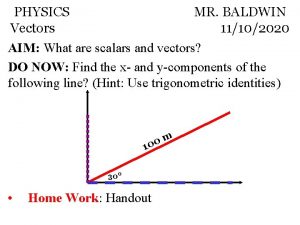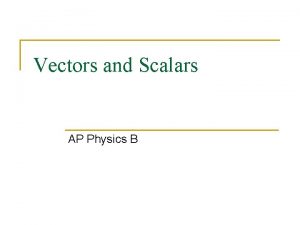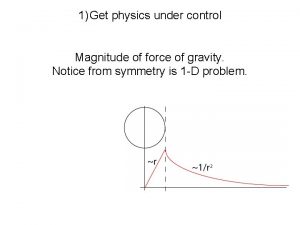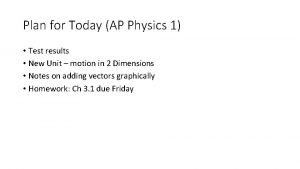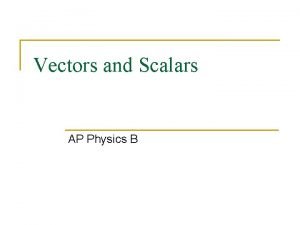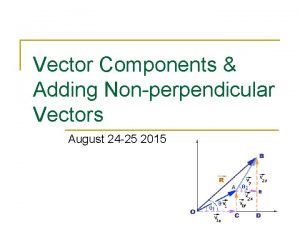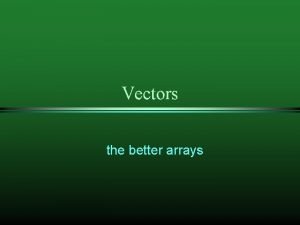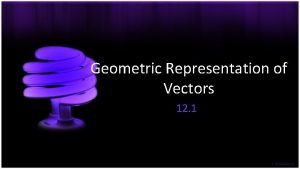AP Physics C Vectors 1 1 Vectors Vectors








- Slides: 8

AP Physics C – Vectors. 1. 1 Vectors. • Vectors are mathematical quantities indicated by arrows. The length of the arrow denotes the magnitude or the size of the vector. We get an indication of the direction of the vector in the way that the arrow is pointed. • If a vector is drawn from the origin, point O, in a 2 or 3 dimensional coordinate system, then we call it a position vector or radius vector. Sometimes this is called a bound vector. Other vectors drawn between any 2 points, except the origin, in a coordinate system are called free vectors. In a 2 -dimensional system for example, a vector may be given by A = (2, 5). The x component of this vector is Ax = 2. The y component is Ay = 5. In 3 dimensions, we may have B = (1, -3, 6). Now we have 3 components; Bx = 1, By = -3, and Bz = 6. • If two vectors look exactly alike with regard to length and direction, then they are exactly the same vector. Positioning of the vectors does not matter.

In the picture to the right, both vectors have a common length and direction, so they are equal. Notice that they all have x components equal to 2, and y components equal to 1. We can also add two vectors together to get a new vector. Consider the picture to the right. First, move to the end of the blue vector, U. Once you get to the end of the vector, start off in the direction parallel to the red vector, V , until you travel a distance equal to the length of V. In the illustration, this total trip is exactly the same as if you had marched along the green vector, W, from the origin in the first place. So we say that U + V = W. Mathematically, for example, if the vector U = (5, 2), and the vector V = (1, 4), the sum of these two vectors, U + V = W = (6, 6). W

Multiplication by a Scalar The next operation we can perform is multiplication by a scalar. If we want to make a vector bigger of smaller, all we do is scale it by multiplying the whole vector by a single number, a scalar. If vector A in the diagram is the small vector starting at the origin, then 3 A also starts at the origin but is 3 times longer tha A. If this scalar is bigger than one, the new vector will point in exactly the same direction as the old, but will be longer. If the scalar is between zero and one, the new vector will not change direction, but will shrink to be smaller than the original vector. Multiplying a vector by a negative scalar has two effects. The first is to make the vector longer or shorter. The second effect is to turn the vector around and make it point in the opposite direction. See diagram above.

Subtracting Vectors Subtracting vectors is really just another way of adding two vectors. The easiest way to think of subtraction is to multiply the components of the second vector by -1, and then add the corresponding x and y components of the two vectors. Thus, subtracting two vectors is really just the same as adding the negative of the second vector to the first. Length or Absolute Value of a Vector If vector X = (3, 4) , then the magnitude or length of vector X is given by |X|. With |X| = √(32 + 42) = √(25) = 5. In other words, just square each component, add them together, and take the square root. Consider a vector Y = (5, 8). We have a law that states |X + Y| ≤ |X| + |Y|. Lets see how it works. X + Y = (3+5 , 4+8) = (8, 12). |X + Y| = √(82 + 122) = √(64 + 144) = √(208) = 14. 422 |X| + |Y| = √(32 + 42) + √(52 + 82) = √(25) + √(89) = 5 + √(89) = 14. 434 As you can see, |X + Y| ≤ |X| + |Y|.

Calculating the Length of a Vector We will need to know how to calculate the length of a vector (known at the magnitude of a vector). This is exactly the same as calculating the distance between two points. For 2 Dimensions: If your vector is defined as (x, y) , • Length = √ (x 2 + y 2) For 3 Dimensions: If your vector is defined as (x, y, z) , • Length = √ (x 2 + y 2 + z 2) For distance between any 2 points, P and Q, with position vectors p = (x 1, y 1) and q = (x 2, y 2) : • Distance = p - q = |p - q| = √ ((x 1 - x 2 )2 + (y 1 - y 2 )2) , notice that this is the same as the Distance Formula.

The Dot Product of Two Vectors (sometimes called scalar or inner product) In 2 Dimensions: If your vectors are defined as p = (x 1, y 1) and q = (x 2, y 2) , then just multiply corresponding x and y components of the vectors. • Dot. Product = p • q = x 1· x 2 + y 1 · y 2 In 3 Dimensions: If your vectors are defined as p = (x 1, y 1, z 1) and q = (x 2, y 2 , z 2) , then again just multiply the corresponding x, y, and z components of the vectors. • Dot. Product = p • q = x 1· x 2 + y 1 · y 2 +z 1 · z 2 Another way to find the Dot Product: p • q = |p|·|q|·cos( ) , where is the angle between p and q. This is also useful in finding the angle between the given vectors p and q.

VECTORS AND SCALARS IN PHYSICS All vectors must have magnitude and direction. Quantities with magnitude only are called scalars. Examples of vectors are: Examples of scalars are: 1. Displacement: 1. Distance: “ 15 m” “walk 5 km North” 2. Speed: “ 15 km/hr” 2. Velocity: 3. Magnitude of Acceleration: “moving 15 km/hr at 30 o North of West” “ 9. 8 m/s 2” 3. Acceleration: “ 9. 8 m/s 2 downward” 4. Others: mass, volume, length, time, …(no direction applies)

MATHEMATICS OF VECTORS 1. COMPONENTS OF A VECTOR: 2. For vector A, Ax = Acosθ and Ay = Asinθ. 3. UNIT VECTORS: i, j, and k. 4. (a) i, points in the x-direction 5. (b) j, points in the y-direction 6. (c) k, points in the z-direction 7. (d) If A = 3 i – 4 j + 2 k and B = -4 i + 6 j – 9 k, then A + B = -i + 2 j – 7 k. This is much easier, don’t you think?

